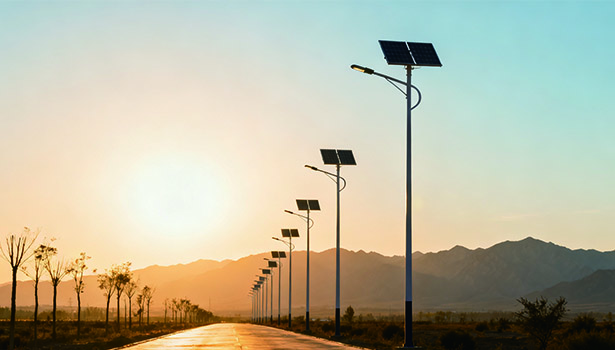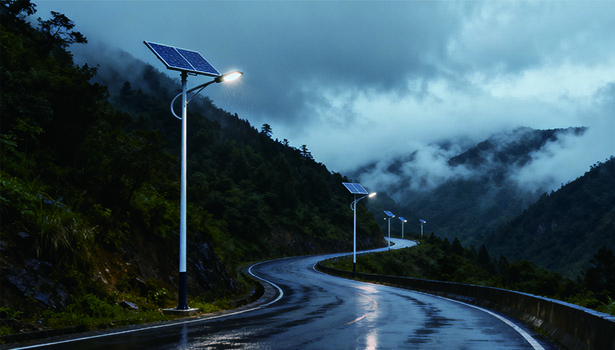The Latest Trends in Street Lighting in South Africa
South African street lighting is undergoing a profound transformation, driven by three core imperatives: sustainability, cost-effectiveness, and adaptability. Historically viewed merely as a tool for basic nighttime navigation, street lighting has evolved into a key pillar for building safer, smarter, and more attractive cities through the integration of smart technologies, solar energy, and human-centered design principles. This article comprehensively analyzes the core trends driving South Africa's street lighting development and explores how they are revitalizing urban growth.

LED Lighting Dominance
Reducing Energy Consumption Pressure
LED street lights consume over 75% less energy than incandescent bulbs. This is particularly significant for South Africa, which faces demands for energy structure optimization. LED lighting substantially reduces electricity consumption, alleviates grid load, and supports national carbon reduction targets. This low-energy characteristic gives LEDs a natural competitive advantage in South Africa's energy-constrained market.
Cost Advantage
LEDs' extended lifespan and low maintenance requirements deliver substantial savings for South African municipal authorities. Below is a core cost comparison between LED and traditional incandescent lighting:
|
Comparison Dimension |
LED Lighting |
Incandescent Lamp |
|
Lifespan |
Over 50,000 hours |
Around 1,000 hours |
|
Annual Replacement Frequency |
0.2 times (based on 2,000 hours/year) |
20 times (based on 2,000 hours/year) |
|
Annual Electricity Cost Savings |
Reduces energy use by about 75% compared to incandescent |
No energy-saving advantage |
|
Total Lifecycle Cost |
Lower |
3–5 times higher than LED |
As shown in the table, while LED have a slightly higher initial purchase cost, they generate substantial long-term savings in electricity and maintenance expenses for municipalities, offering a significant life cycle cost advantage.
Light Quality Upgrade
LED street lights offer superior color rendering index and directional light emission, accurately reproducing true object colors while reducing glare. This advantage significantly enhances visibility on roads and sidewalks at night, enabling drivers and pedestrians to better assess their surroundings and reduce traffic accident risks. High-quality illumination also boosts the sense of security in public spaces, playing a positive role in preventing public safety incidents.
Smart Street Lighting System
Adaptive Dimming
The system automatically adjusts brightness based on real-time traffic flow, weather conditions, and time-of-day variations. For instance, lighting can be reduced to 30% brightness during late-night low-traffic periods and automatically restored to full brightness before the pre-dawn commute peak. This dynamic adjustment avoids energy waste caused by “permanently full brightness,” precisely matching lighting supply with actual demand while balancing energy efficiency and user experience.
Remote Monitoring
Through a central control platform, operators can monitor the operational status of every street light in real time. Without on-site inspections, they can track brightness levels, energy consumption, and malfunctions. Upon detecting a failed or malfunctioning light, the system immediately triggers an alarm and pinpoints the exact location. This reduces repair response times from days to hours. Efficient fault resolution ensures continuous street lighting, safeguarding citizens' nighttime travel safety.

IoT Integration
As “sensing nodes” in smart cities, these intelligent street lights collect multidimensional data including traffic flow, air quality, and noise levels. This data is transmitted via IoT to urban management platforms, providing scientific decision-making support for traffic flow optimization, environmental governance, and public service enhancement. For instance, analyzing traffic flow data enables traffic light timing adjustments to improve road efficiency, elevating urban management precision.
Solar Street Lights
South Africa boasts world-leading solar radiation resources, with average annual sunshine hours reaching 2,500–3,000. These exceptional natural conditions have accelerated the adoption of solar street lights, making them a key choice for street illumination.
Sustainability
Solar street lights operate entirely on renewable solar energy without requiring grid connection, reducing reliance on fossil fuels at the source. In remote, off-grid rural areas, these lights have successfully addressed basic lighting needs, enhancing nighttime safety for villagers. Simultaneously, the use of clean energy supports South Africa's fulfillment of international carbon reduction commitments and advances sustainable urban development.
Long-Term Cost Efficiency
Although solar street lights have higher initial installation costs than traditional street lights, they offer significant life cycle cost advantages. After a one-time investment, users can permanently harness free solar energy, eliminating monthly electricity bills. With solar panels lasting up to 25 years and requiring minimal maintenance, the initial investment typically pays off within 5-7 years. For local governments with tight budgets, the long-term benefits far outweigh the initial investment pressure.
Hybrid Systems
To address insufficient solar supply during cloudy or rainy weather, solar-grid hybrid systems are gaining traction. These systems automatically switch power sources, prioritizing solar when available and seamlessly transitioning to grid power during shortages. This approach preserves solar's environmental benefits while resolving the instability of standalone solar systems, ensuring 24/7 uninterrupted lighting.
Motion Sensors
Motion sensors have become standard equipment in South African street lighting. Their “detect-and-illuminate” dynamic mode simultaneously fulfills energy-saving objectives and safety requirements.

Ultimate Energy Efficiency
When sensors detect no vehicle or pedestrian movement in the area, street lights automatically dim to a low-power standby mode, reducing energy consumption by over 60%. Upon detecting motion, they instantly restore full brightness to ensure adequate illumination for users. This “light on when people come, light off when people leave” mode maximizes energy savings and optimizes lighting resource utilization.
Crime Deterrence
Sudden high-brightness illumination at night effectively deters potential criminal activity, reducing incidents like theft and vandalism. In high-security areas such as residential neighborhoods and commercial alleys, motion sensors provide particularly noticeable deterrence. Criminals often hesitate when confronted by sudden light, fearing exposure and abandoning their intentions, thereby enhancing public safety.
Sustainable Materials
South Africa's commitment to sustainable street lighting extends to luminaire materials, implementing eco-friendly practices from the production stage.
Recycled Components
Manufacturers increasingly utilize recycled aluminum, reclaimed plastics, and glass for lamp housings and components. This reduces environmental strain from virgin material extraction, decreases landfill waste, and embeds sustainability into production—advancing circular economy principles.
Aesthetics and Architectural Lighting
Integrating with Urban Architectural Styles
Cities like Cape Town, Johannesburg, and Durban select customized luminaires tailored to distinct district identities. Modern minimalist linear lights accentuate the sophistication of commercial zones, while vintage-style street lamps complement historic districts to highlight cultural heritage. This harmonious integration of lighting and architectural styles enhances the visual appeal and cohesion of urban spaces.
Enhancing Place-Making
Lighting highlights landmark buildings, park landscapes, and public artworks, transforming ordinary public spaces into distinctive destinations. For instance, Cape Town's Table Mountain-adjacent street lights artfully trace the mountain's silhouette, creating a unique nocturnal vista. This not only boosts civic belonging and happiness but also drives tourism and local commerce, infusing the city with vitality.
The future of South African street lighting is advancing toward a vision of “smarter, greener, and more people-centric” solutions. The deep integration of technologies like LED, solar power, and IoT, coupled with the adoption of innovative models such as LaaS (Lighting as a Service), will fundamentally transform street lighting. Future South African streets will not only provide stable, efficient illumination but also become integral components of smart cities. They will create safer, more comfortable, and livable environments for citizens while continuously fueling the sustainable development of urban areas.




